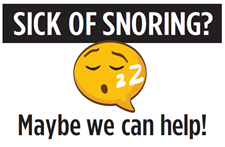What we offer.
Over-the-counter devices. These are generally the best of the types available and are chosen for quality and price.
They are great to use as a trial to see whether or not you need either a custom-made appliance, CPAP or surgery.
- Nose Cones. (Nasal Dilators)
- Sprays
- Custom made and other anti-snoring devices.
We have determined that by bulk-buying we can offer these at very competitive prices and are cheap enough to try.
Snoring. How we approach snoring.
The first thing to determine is where in the airway is the main point where snoring is generated.
The next is will a mouth-device alter this situation and reduce the noise but not by making breathing more difficult.
Then choose the best device that achieves the above.
Out of hundreds, most of which Dr. Zimmerman has experience with he prefers and usually chooses a simple design that will maintain a patent airway and is small enough not to take up valuable space.
For example the top-bottom anti-snoring devices wont work if you cant nose-breathe. Most bulky ones are a single unit and you simply cannot mouth-breathe. Their benefit lies in repeated nose-breathing will often reduce inflammation and swelling in the nose and so over time nose breathing improves and is far better than mouth-breathing.
But if you simply cannot nose breathe this is not a path to go down.
Finally confirming the airway is open and improved. Using sonar to scope the airway it is possible to know where the constrictions are and if the repositioning helps.
A recent example being an 80 year young woman, who had increasingly difficult health issues had her airway measured. It was alarmingly narrow. Where the narrowest point has been agreed at 2.9 square centimetres hers was 0.77 sq. cms No repositioning could make much difference. But taking the best position and increasing the thickness of just the front that constriction point became 1.47 sq cms – that is it doubled. Twice the diameter means four times as much air goes through the airway. She reported her first sound sleep in years and only went to the toilet once rather than 3 or 4 times. This is not a cure, but a vital help.

